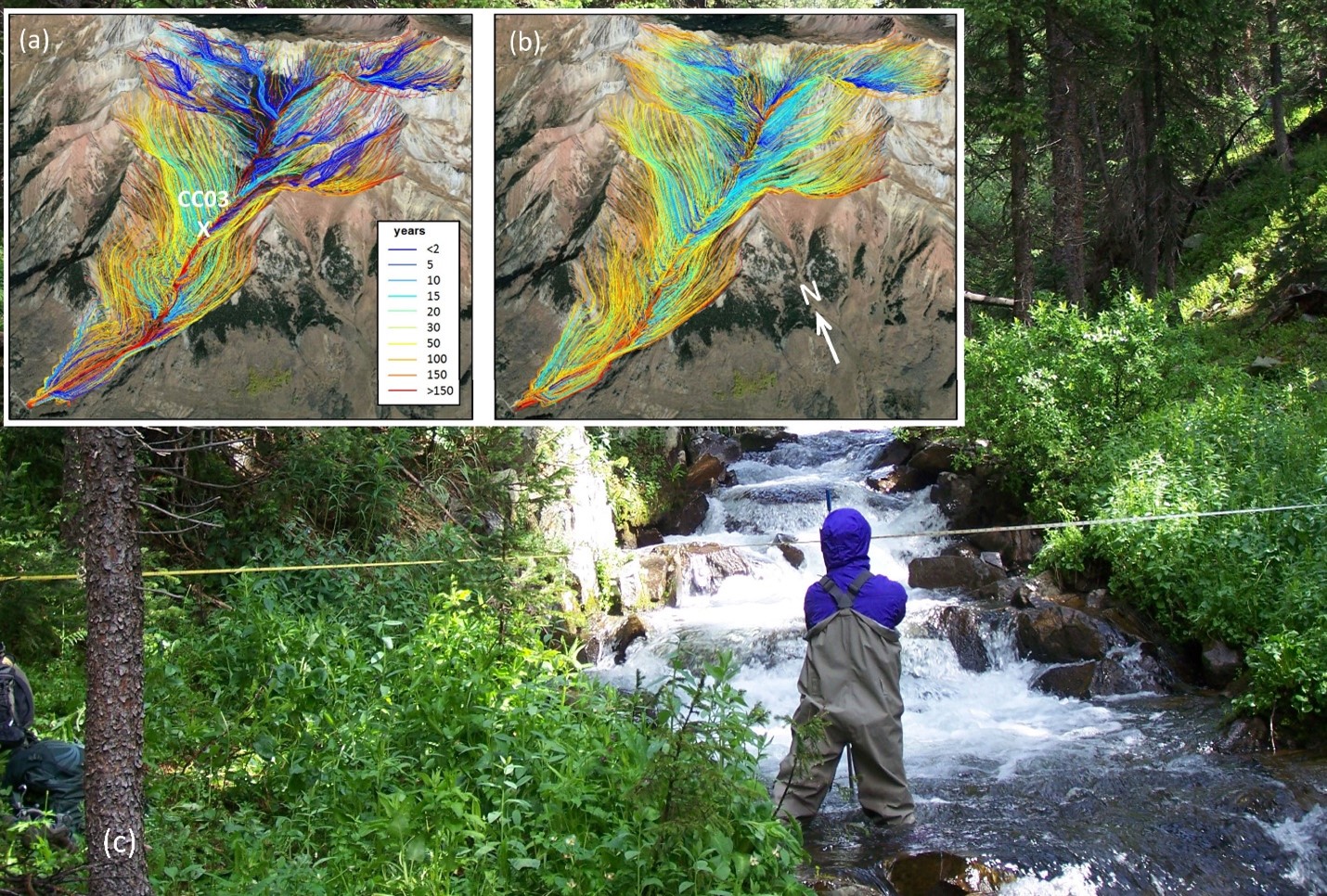December 05, 2020
Groundwater Age in a Colorado River Headwater Stream
Exploring the sensitivity of groundwater age to snow dynamics and watershed structure.

Groundwater flow paths in Copper Creek, Colorado, and their ages for the (a) previously published hydrologic model, and (b) recalibrated hydrologic model using gas tracers collected in stream water at CC03. (c) Measuring stream discharge in a tributary of Copper Creek.
[(a-b) Reprinted under a Creative Commons Attribution 4.0 International License (CC BY 4.0) from Carroll, R.W.H., Manning, A.H., Niswonger, R. et al. “Baseflow age distributions and depth of active groundwater flow in a snow-dominated mountain headwater basin.” Water Resources Research 56(12), e2020WR028161 (2020). [DOI:10.1029/2020WR028161] (c) David Marchetti.]
The Science
Older groundwater that flows through deep bedrock in mountain watersheds could be important to stream water, but limited data on bedrock properties often limits the ability to examine and understand its role. To address this, the authors combined a novel stream water gas tracer experiment in a steep mountain stream in a Colorado River headwater basin (24 km2) with a previously published hydrologic model to examine relationships between streamflow age variability, shallow and deeper groundwater flows, and climate conditions. Results indicate streamflow age in the late summer varies interannually (3–12 years) as a function of shallow, subsurface flow (<1 year) that is controlled by snow dynamics. In contrast, deeper groundwater ages remain stable (12 years) across historical conditions.
The Impact
Age tracer observations in streamflow provide a novel and relatively cost-effective method to indirectly characterize bedrock properties in a steep, snow-dominated watershed that can lead to new insights into watershed functioning. The added information from the tracer data suggests more deeper groundwater flow occurs than previously thought. Collecting stream water gas data also helped identify groundwater flow path sensitivity to climate and land-use change. Under wetter conditions, groundwater flow paths and ages are insensitive to climate change or forest removal. A sensitivity analysis indicates that the basin is close to a precipitation threshold. With only small shifts toward a drier state, groundwater flow paths will become increasingly deeper and groundwater age in the stream increasingly older.
Summary
There is growing awareness that deep bedrock in steep, mountain watersheds could be an important part of a watershed’s hydrologic system, but the true importance of deeper groundwater flow remains largely unknown. Here the scientists present a proof of concept for a new and efficient approach to characterize deeper groundwater flow in a mountain watershed using stream water concentrations of N2, Ar, CFC-113, and SF6. Using gas tracer observations, the scientists provide solid evidence of nontrivial groundwater flow to streams that occurs at considerable depth in a mountain watershed underlain by fractured crystalline rock.
The implication for this revised conceptual model of groundwater flow in this mountain watershed is substantial. Using age tracers to inform an integrated hydrologic model, the scientists move Copper Creek from a topographically controlled basin with hyper-localized groundwater flow paths (young ages) that are insensitive to changes in precipitation to a borderline recharge-controlled groundwater basin in which groundwater flow paths are extremely sensitive to increased aridity and forest structural change. This study clarifies the importance of characterizing the bedrock groundwater system in steep mountain watersheds to predict how groundwater and surface water interactions may respond to future changes in climate, land cover, or land use.
Principal Investigator
Rosemary W.H. Carroll
Desert Research Institute, Reno, NV
[email protected]
Funding
U.S. Geological Survey 104(g) Grant/Cooperative Agreement No. G16AP00196 funded gas tracer analysis.
U.S. Department of Energy Office of Science under contract DE-AC02-05CH11231 as part of Lawrence Berkeley National Laboratory Watershed Function Science Focus Area funded time for Dr. Carroll and Dr. Williams.
U.S. Geological Survey Mineral Resources Program funded time for Dr. Manning.
NSF ROA award #1624073 helped fund time for Dr. Marchetti.
Bartleson-Prather Research Fund supported field assistance from Western Colorado University undergraduate Manya Ruckhaus.
References
Carroll, R. W. H., A. H. Manning, R. Niswonger, et al. . "Baseflow age distributions and depth of active groundwater flow in a snow-dominated mountain headwater basin." Water Resources Research 56 (12), e2020WR028161 https://doi.org/10.1029/2020WR028161.

